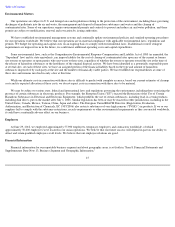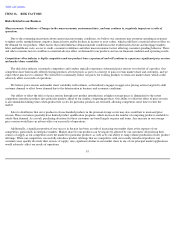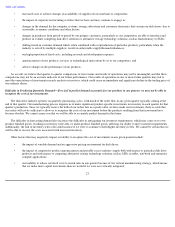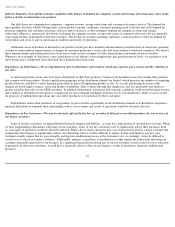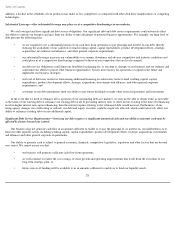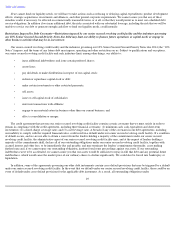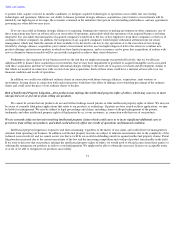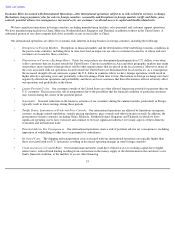Seagate 2011 Annual Report Download - page 28
Download and view the complete annual report
Please find page 28 of the 2011 Seagate annual report below. You can navigate through the pages in the report by either clicking on the pages listed below, or by using the keyword search tool below to find specific information within the annual report.
Table of Contents
Industry Demand
—Poor global economic conditions and changes in demand for computer systems and storage subsystems may cause in the
future a decline in demand for our products.
Our disk drives are components in computers, computer systems, storage subsystems and consumer electronics devices. The demand for
these products has been volatile. During times of poor global economic conditions, consumer spending tends to decline and retail demand for
personal computers and consumer electronics devices tends to decrease, as does enterprise demand for computer systems and storage
subsystems. Moreover, unexpected slowdowns in demand for computer systems, storage subsystems or consumer electronics devices generally
cause sharp declines in demand for disk drive products. The decline in consumer spending could have a material adverse effect on demand for
our products and services and on our financial condition and results of operations.
Additional causes of declines in demand for our products in the past have included announcements or introductions of major new operating
systems or semiconductor improvements or changes in consumer preferences, such as the shift from desktop to notebook computers. We believe
these announcements and introductions have from time to time caused consumers to defer their purchases and made inventory obsolete.
Whenever an oversupply of disk drives causes participants in our industry to have higher than anticipated inventory levels, we experience even
more intense price competition from other disk drive manufacturers than usual.
Dependence on Distributors
—We are dependent on sales to distributors and retailers, which may increase price erosion and the volatility of
our sales.
A substantial portion of our sales has been to distributors of disk drive products. Certain of our distributors may also market other products
that compete with our products. Product qualification programs in this distribution channel are limited, which increases the number of competing
products that are available to satisfy demand, particularly in times of lengthening product cycles. As a result, purchasing decisions in this
channel are based largely on price, terms and product availability. Sales volumes through this channel are also less predictable and subject to
greater volatility than sales to our OEM customers. In addition, deterioration in business and economic conditions could exacerbate price erosion
and volatility as distributors lower prices to compensate for lower demand and higher inventory levels. Our distributors' ability to access credit
for purposes of funding their operations may also affect purchases of our products by these customers.
If distributors reduce their purchases of our products or prices decline significantly in the distribution channel or if distributors experience
financial difficulties or terminate their relationships with us, our revenues and results of operations would be adversely affected.
Dependence on Key Customers
—We may be adversely affected by the loss of, or reduced, delayed or cancelled purchases by, one or more of
our larger customers.
Some of our key customers, including Hewlett-
Packard Company and Dell Inc., account for a large portion of our disk drive revenue. While
we have longstanding relationships with many of our customers, if any of our key customers were to significantly reduce their purchases from
us, our results of operations would be adversely affected. While sales to major customers may vary from period to period, a major customer that
permanently discontinues or significantly reduces its relationship with us could be difficult to replace. In line with industry practice, new
customers usually require that we pass a lengthy and rigorous qualification process at the customer's cost. Accordingly, it may be difficult or
costly for us to attract new major customers. Additionally, mergers, acquisitions, consolidations or other significant transactions involving our
customers generally entail risks to our business. If a significant transaction involving any of our key customers results in the loss of or reduction
in purchases by these key customers, it could have a materially adverse effect on our business, results of operations, financial condition and
prospects.
25


